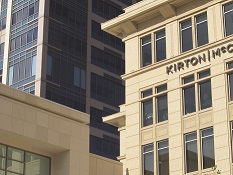
 Locating a company headquarters is often thought of as an activity limited to major corporations. The truth is midsize companies face the same daunting task of defining the optimum location for the company headquarters as the company expands. Consider the situation in the following case study.
Locating a company headquarters is often thought of as an activity limited to major corporations. The truth is midsize companies face the same daunting task of defining the optimum location for the company headquarters as the company expands. Consider the situation in the following case study.
The Journey of a Real Midsize Headquarters Expansion
A privately held company with 50 employees is on a steep growth curve and is seeking to expand its business by 10-fold over the next five years. It is currently located in a relatively small city of 50,000 about an hour and a half from a major metropolitan area that has a regional airport.
The company is staffed by family members as well as talent from the community at large. The company works as a team, each member shares the vision and passion for the company and its products that consist of aftermarket vehicle accessories marketed over the web. The company also manufactures some product lines in the region.
Up to this point in the company’s history, all has been well. The labor resources it has needed for customer interface, web development, back-office and leadership have been available locally, supported by the local college and high school tech programs that provide needed training, particularly in web design and IT functions.
The president of the company is beginning to worry about the future, though. His concern is if the company is to grow and achieve its potential, as it desires to do, will it be able to find additional staff and more technically advanced, market-savvy talent in the local area? His assumption is the company will probably need to embark on an aggressive recruiting campaign in larger metro areas, but will candidates have an interest in living in a more remote area that has limited spousal employment and amenities?
As the company grows, there will be more travel to new markets and the need to meet and engage with business partners. With the airport well over an hour away, will travel time become excessive? Are there locations that will provide a broader market exposure for the company?
 Weighing the Facts
Weighing the Facts
To address these concerns and potential issues at this point in the expansion journey, a study of the organization and location was conducted for the firm to determine the best deployment options as the company planned its expansion. The history of the company was reviewed along with its primary success factors. The key functions within the company were identified along with related skill requirements and locational considerations. A five-year staffing projection was made and growth within selected functions was estimated along with overall space requirements. To support company growth, strategies for recruiting staff within each functional area were considered.
Alternative cities were selected for comparison based on multiple criteria identified with input from the company leadership team and included:
-
Current headquarters presence
-
The level of automotive manufacturing and events/venues related to automotive racing and car shows
-
The cost of operations based on real estate, labor and taxes
-
Air access and travel time to selected destinations
-
The cost of living and housing that impacs quality of life.
The Strategy Choices
Based on the organization and location analysis, there were three deployment options that were evident:
-
Retain all functions in the current city and address recruiting challenges as needed
-
Relocate the headquarters function to a larger city and retain the back-office functions in the current location
-
Relocate the entire operation to a larger city.
Decision Complications
Making a decision based on these choices may seem straightforward to some, but for the emerging company like the one in this example that has never faced such a decision, it is fraught with issues – particularly if the owners are originally from the current location. Another factor that needs to be considered is that a small company with an unknown brand will not get the traction in recruiting in a large city it enjoyed in its hometown. In addition, the cost of operations will go up, and in some cases, dramatically. There is also the challenge of paying for the relocation as well as the potential loss of key employees who choose to remain in the current location.
 Considerations for Remaining in the Smaller City
Considerations for Remaining in the Smaller City
There are a number of instances where major companies have decided to stay in smaller hometown communities, such as WalMart in Bentonville, Arkansas; Corning Incorporated in Corning, New York; Fisher Price in East Aurora, New York; and Pella Corporation in Pella, Iowa. Keeping a growing company in a smaller city can be done, but it takes a substantial amount of effort to build a company culture and a community environment that attracts outsiders to the area.
When a company is relatively small, recruiting is primarily focused on local labor that is attracted to the culture of the company and the jobs it provides. When the company is relatively large and is well-known within its industry, recruits will relocate to the community just to work for the company and gain valuable experience. However, when a company is virtually unknown but rapidly expanding in a small town, it faces the issue of attracting talent to the community that has a perceived risky and limited job market – this is when recruiting to a smaller city is very challenging. Remaining in a smaller city is a viable alternative, but it will take very selective and creative recruiting efforts to staff jobs from the outside.
There are also instances when an emerging company that starts up in a large city opts to relocate to a smaller city that may have access to a local college for key talent, outdoor activities, a great “small town” quality of life and low operating cost. This becomes both a business and lifestyle choice for the owners, and there are many successful examples of this strategy.
Considerations for Relocating to the Larger City
Relocating to a larger city with lots of amenities, business services, transportation access and talent seems like the “natural” option for many growing companies. There certainly are countless examples of how this strategy has been successful. There are a few points of caution for companies that are anxious to make the move. First, estimate the financial and organizational impact of relocation as well as the differential operating cost. Second, consider the competition for talent that will be faced when the company goes head to head with major employers that have very competitive compensation packages.
Being able to compete in a larger city requires that a company has a culturally “cool” product and work environment that sets it apart in the labor market. The Gen X workforce rates the company culture and its products or services as critical and compensation as secondary – but still very much a factor. They do not look long-term at the company, but view it as just an opportunity for the next job and will leave for another company on a whim. This brings some added challenges to staffing and continuity of institutional knowledge within the organization.
 One benefit of smaller cities is that worker loyalty tends to be much stronger, partly because the options are limited, but also because they value the “family” atmosphere and sense of teamwork that evolves over time. In essence, there are some soul-searching issues that need to be considered when selecting the size of a location as it relates to the size of the company and its life-cycle stage.
One benefit of smaller cities is that worker loyalty tends to be much stronger, partly because the options are limited, but also because they value the “family” atmosphere and sense of teamwork that evolves over time. In essence, there are some soul-searching issues that need to be considered when selecting the size of a location as it relates to the size of the company and its life-cycle stage.
General Insights for Midsize Company Headquarters Decisions
In the life of every company there are decision points about where the company headquarters, and other operations, should be located. Companies decide to stay put or move to another location for a multitude of reasons. With that in mind, following are some experience-based, general guidelines for making location decisions.
-
Does the company need to be located all in one location or is the organization prepared to separate portions of the company in different locations? As technology-based companies expand, they tend to keep the headquarters with R&D along with some manufacturing capability in order to monitor new processes as they ramp up. Back-office functions can be located in a separate location. Companies may keep all the functions together by selecting a larger city that has a moderate cost structure but still has the access to markets, quality of life and business services they require to grow.
-
Perform a rough cost estimate that covers the cost of relocation and the ongoing operating cost for a proxy larger city. Depending on the cost of employee housing, the average cost of relocating an executive can be $50,000 to $75,000 or more and the cost of commercial real estate may be two times or more the cost in the current location. The cost of taxes and labor may also bring some sticker shock. Knowing these costs can help a company receive a shot of reality early in the process and help calibrate expectations.
-
Make a rough determination as to which members of the leadership, technology and other critical staff are both willing and able to make the relocation. Assess the impact on the company if certain members will not relocate, but also consider that arrangements can be made to telecommute or and other options to accommodate legitimate issues.
-
If the company is serious about evaluating location options, utilize a well-structured approach that is objective and will hold up to the scrutiny of the less-than-enthusiastic members of the leadership team. From experience, there are always individuals who seek to manipulate the outcome of the location analysis to meet their individual needs. We have made major changes in our location analysis approach over the years to address this issue.
-
Before a location decision is made, as in other major purchases, test out the “product” and make sure it is a good fit for the company. Send a few individuals to the location for a week or so to get the feel of the city and arrange to have discussions with existing companies. Tour neighborhoods and find out about the quality of specific schools. Try commuting to the airport in the morning, test out some of the restaurants and have a commercial broker show you some potential properties. Keep in mind that living and doing business in a location on an ongoing basis takes on a very different perspective than a casual business trip. Traffic in a larger city may be intimidating and it just might drive the notion that there is “no place like home.”
-
In most circumstances, a relocation event is a form of trauma for a business, its employees and their families. It is very important to establish a formal means of communication throughout the relocation process to keep everyone focused and upbeat. If it is too expensive to send families to the new location on a familiarization trip, bring the community to the families by offering access to brokers, websites and a group meeting where the attributes of the location are presented in a “job fair” format.
-
It is important to conduct the relocation in an equitable manner. In fact, there are requirements that employees of equal status be treated the same as far as relocation benefits. The best way to address any potential issues is to prepare a relocation policy that outlines what an employee will receive in benefits if they relocate or if they choose to terminate their employment at a defined date. It is important for some jobs to have an overlap in employment between the existing and new employees to transfer job knowledge.
Location plays a critical role in the success of any company. The value of a specific location will vary by company and by the lifecycle stage they are in. The process of location selection and then relocation is well-defined and if done effectively will produce good results. Each company must determine what is best for it and be prepared to adapt and make changes, but also realize that the grass may not always be greener in another city.

